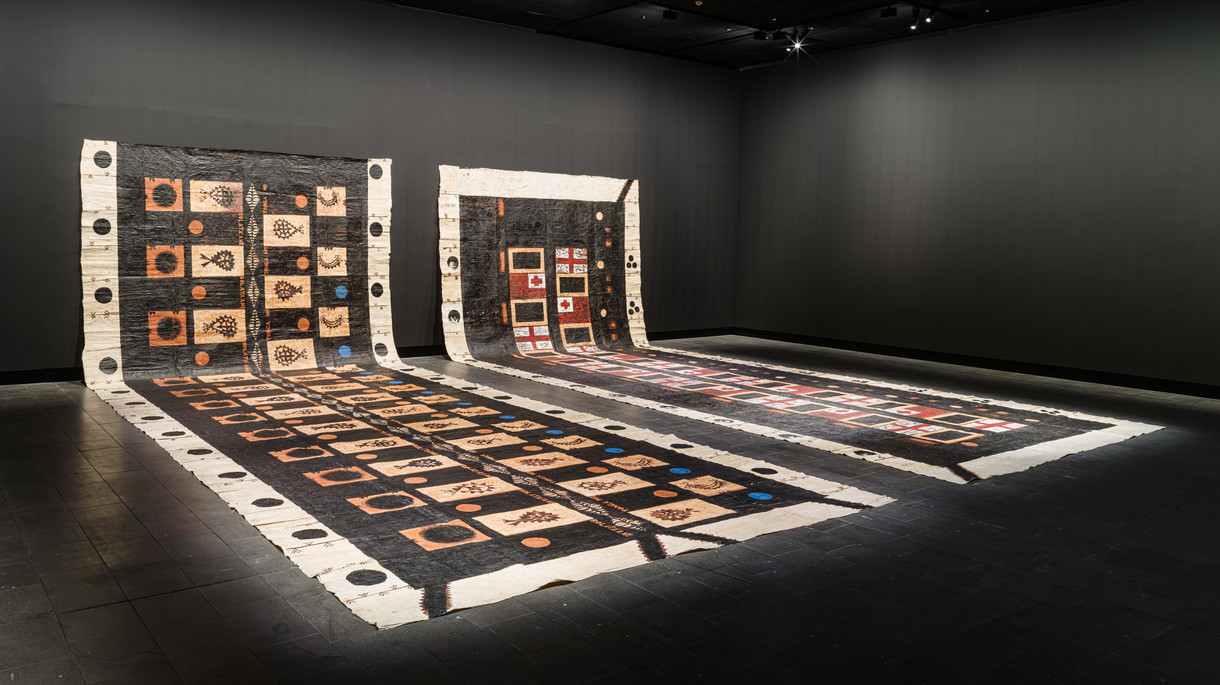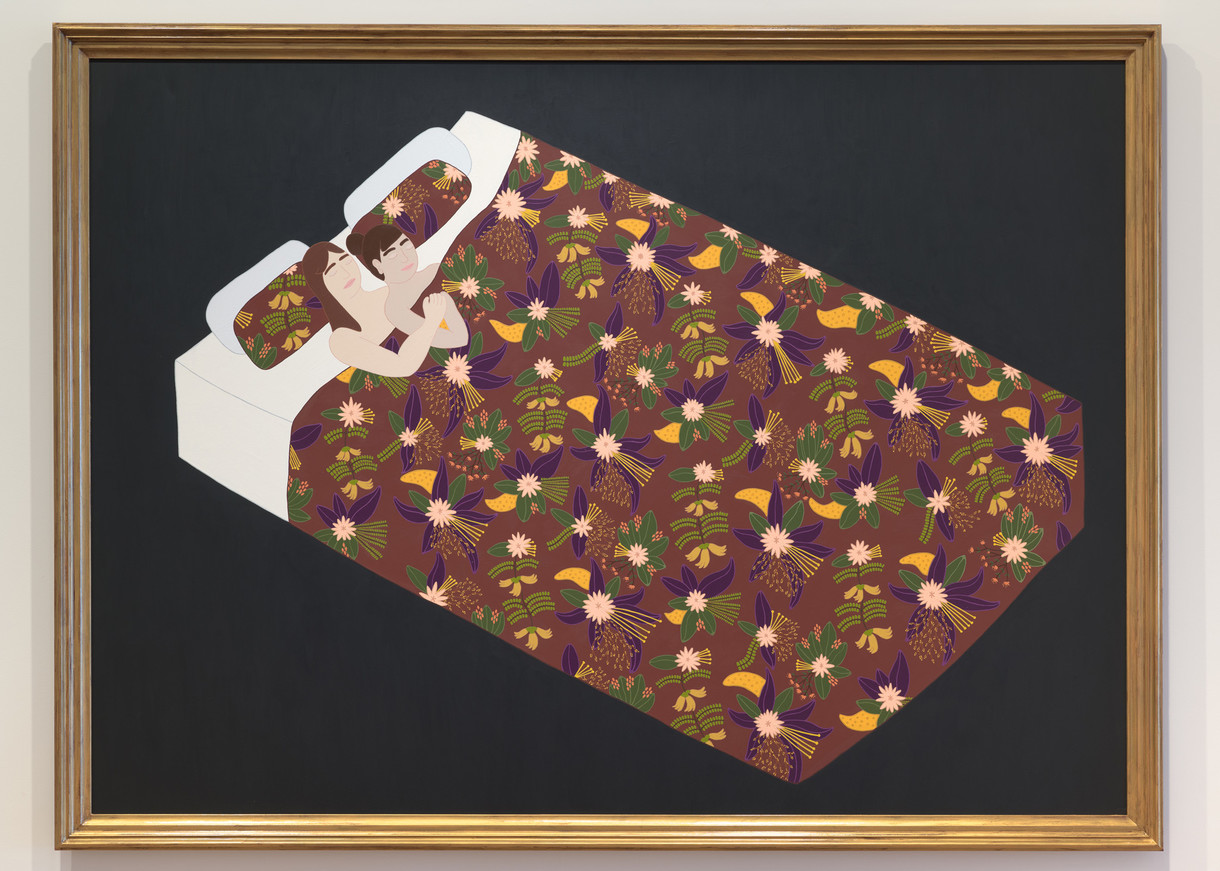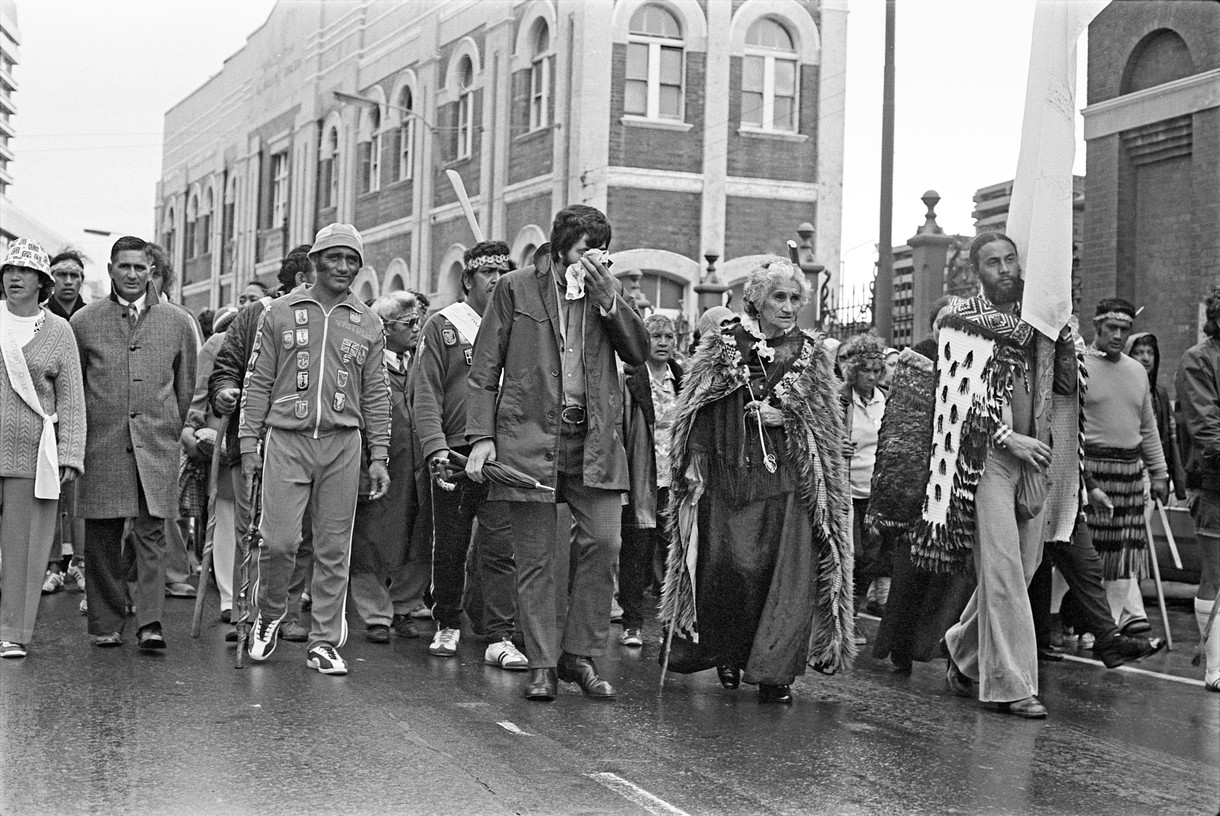The Meeting of Two Queens

Kulimoe'anga Stone Maka Toga mo Bolata'ane (Tonga and Britain) and Kuini Haati 2 (Two Queen Heart) (detail) 2008–10. Oil, clay, dye on tapa cloth. Installation view, 22nd Biennale of Sydney (2020): NIRIN, Museum of Contemporary Art Australia, Sydney. Courtesy the artist and Museum of Contemporary Art Australia. Photo: Zan Wimberley
A blue dot – warm, mid-blue – that repeats across Tongan artist Kulimoe'anga Stone Maka’s ngatu tā'uli Toga mo Bolata'ane (Tonga and Britain) (2008–10) recalls the first time the artist saw blue eyes.
Stone is about 8 or 10 years-old. The colossal cruise ship Queen Elizabeth II pulls into Queen Sālote Wharf, her wide black hull and pristine white upper decks interrupting the expanse of green-blue sea and sky. His dad tells him to run down and hold up the seashells he has cleaned for tourists. Stone holds the shells out in front of him. A Pālagi tourist takes a curved cowrie, or else a spiralling brown conch, and throws down some coins. Maybe the tourist’s blue eyes seem funny or pale or friendly or hostile. Stone doesn’t yet know the significance blue eyes will have for him.
As the cruise ship leaves, an elderly woman runs into the sea. The tide breaks around her thin legs. Tears gather over her worn cheeks. She is moved and sad and joyful simultaneously. She is waving a white handkerchief. Stone asks his dad whether her family has gone on the ship. No, his dad explains, she remembers the Queen’s visit. She remembers when Queen Elizabeth II came to the Kingdom of Tonga, after Queen Sālote attended her coronation. The feeling of remembering something sacred.
Stone Maka’s two pieces Toga mo Bolata'ane (Tonga and Britain), and Kuini Haati 2 (Two Queen Heart) (2008–10) are large-scale works on ngatu tā'uli, a black form of tapa that enables him to “modernise” the form. But as he explains, the form is “already modern”. Stone’s point is not simply that ngatu tā'uli is recent, but that it is abstract – albeit outside of the Eurocentric lens of Western art history, which considers abstraction as an innovation that emerged from European modernism.
Ngatu tā'uli has traditionally been used for high-ranking people, including royalty and chiefs, given at weddings and births and funerals. When Stone started making ngatu ta'uli he used the traditional process, burning bark and leaves to make the smoke residue that colours the ink. Now he paints the tapa cloth with a mix of dye, oil paint and smoke. The tapa he uses is made by his mum and his sister. The hiapo plant is grown for three years, then the stem is stripped and the inner part beaten with an ike, a wooden beater.
Stone explains that the designs I associate with Tongan ngatu – like the doves flying endlessly upward I remembered on a large ngatu on our wall when I was a child – were also modern: those designs originated after missionaries came from London. Ngatu makers loved trying new things. On Toga mo Bolata'ane there are motifs depicting the sisi garlands of flowers made for Queen Sālote to wear for the royal visit.
It is 1953 and against grey London skies, Queen Sālote smiles warmly from a black open-topped horse-drawn carriage. Rain pours from the sky. Unlike the other dignitaries who kept their carriages closed, Sālote stays smiling and waving at the crowds. The British public love her.
Queen Sālote gives a television interview in Sydney: “I met the Queen and the Duke of Edinburgh several times, and they are most charming. The coronation was a great occasion and the memories of it will never die, although I got a good soaking” – she pauses to give a cheeky smile – “but I thoroughly enjoyed it.”
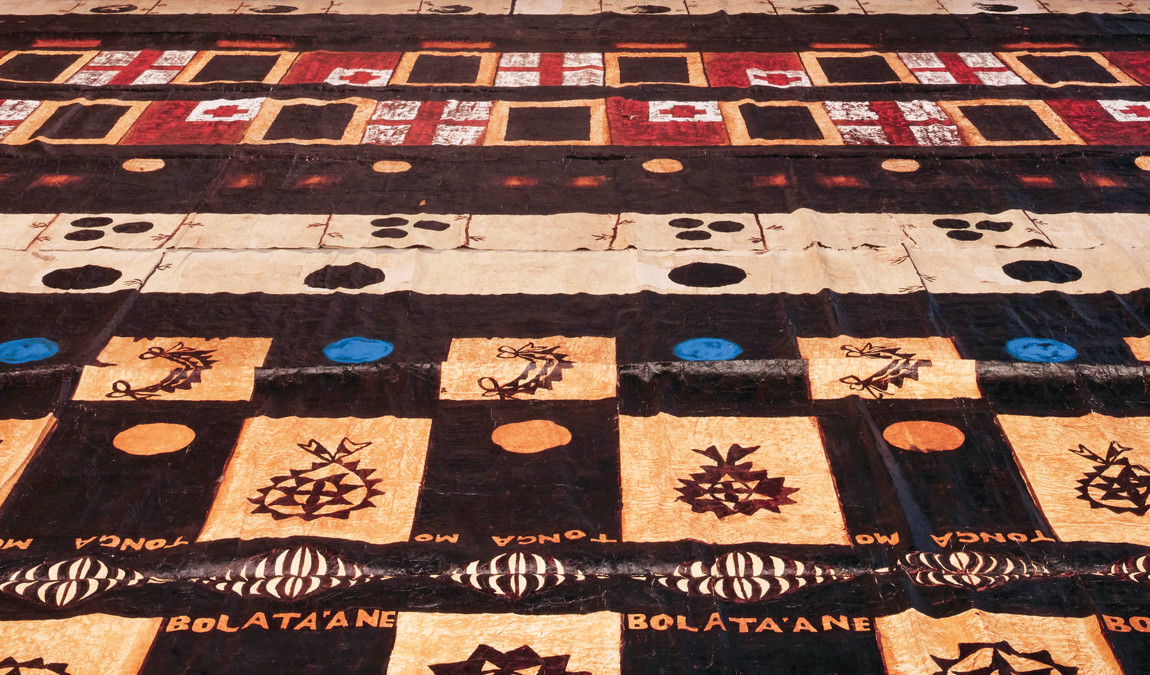
Kulimoe'anga Stone Maka Kuini Haati 2 (Two Queen Heart) and Toga mo Bolata'ane (Tonga and Britain) (detail) 2008–10. Oil, clay, dye on tapa cloth. Installation view, 22nd Biennale of Sydney (2020): NIRIN, Museum of Contemporary Art Australia, Sydney. Courtesy the artist and Museum of Contemporary Art Australia. Photo: Zan Wimberley
Later that year, Queen Elizabeth II chooses to visit Tonga on her six-month tour of Commonwealth countries. There’s an amazing photograph of the two queens walking side-by-side on an expanse of ngatu. Queen Elizabeth wears a pale gold dress and a white hat and gloves. Both queens carry rounded white handbags. Queen Sālote carries a fan. Elizabeth looks fairly relaxed and optimistic, she is followed by an attendant carrying a parasol to shade her from the warm sun. Sālote looks serene.
What did the two queens discuss? At that time they were the only female sovereigns in the Commonwealth, so perhaps they felt some relief to talk to each other, as well as mutual admiration. Sālote had ruled since she became queen in 1917 at 18. In her 1990 biography of the monarch, historian Elizabeth Wood-Ellem says that in contrast to the genial and charismatic image Queen Sālote had offshore, she was an intelligent and strong leader who dealt with internal opposition from some chiefs.
In contrast, the new Queen Elizabeth was only 27. She was shy. Did they make small talk, discuss constitutional monarchies, or chat about their families? Elizabeth’s trip took her away from her two small children for six months.
Maybe they would have privately wanted to discuss the costs of duty and service, and whether their public lives ate into their family lives. But it’s hard to imagine either of them letting their guards down during the stifling 1950s. There were no Brene Brown TED talks about vulnerability. Or royal interviews with Oprah, for that matter. Queen Sālote was an amazing poet and lyricist, so they may have talked about poetry. But poetry is dangerous – so much heliaki, or metaphoric language.
When I talk to Stone Maka about his work, he says the queens were “like sisters”. I know Stone has a sister, so I’ll take that to mean the bond is vital; like that of someone who will grow hiapo plants and then spend hours stripping bark and beating the hiapo with an ike until it forms feta'aki to send it to you to paint on. In my family, siblings meant someone who will do anything to keep you alive – I was an older sister tasked with keeping the younger ones warm and breathing.
In Kuini Haati 2, the red Tongan flag with its red-on-white cross in the top-left corner is paired with the red-on-white cross of the English flag, albeit the old St George’s Cross. The dark ngatu makes the flags look worn. They alternate and repeat, but separating them are squares of black. I think of reverence, of life and death, and the double-stranded helix of DNA. It also bears two dates: 1900, the year the treaty of friendship with England was signed, and 1970, the year the treaty ended.
In Tonga, the royal family was a strategy for resisting colonisation. Chief Taufa'ahau was heir to the chiefly title of Tu'i Kanokupolu, and in 1820 became ruling chief of Ha'apai. He converted to Christianity, and adopted the name George Tupou I.
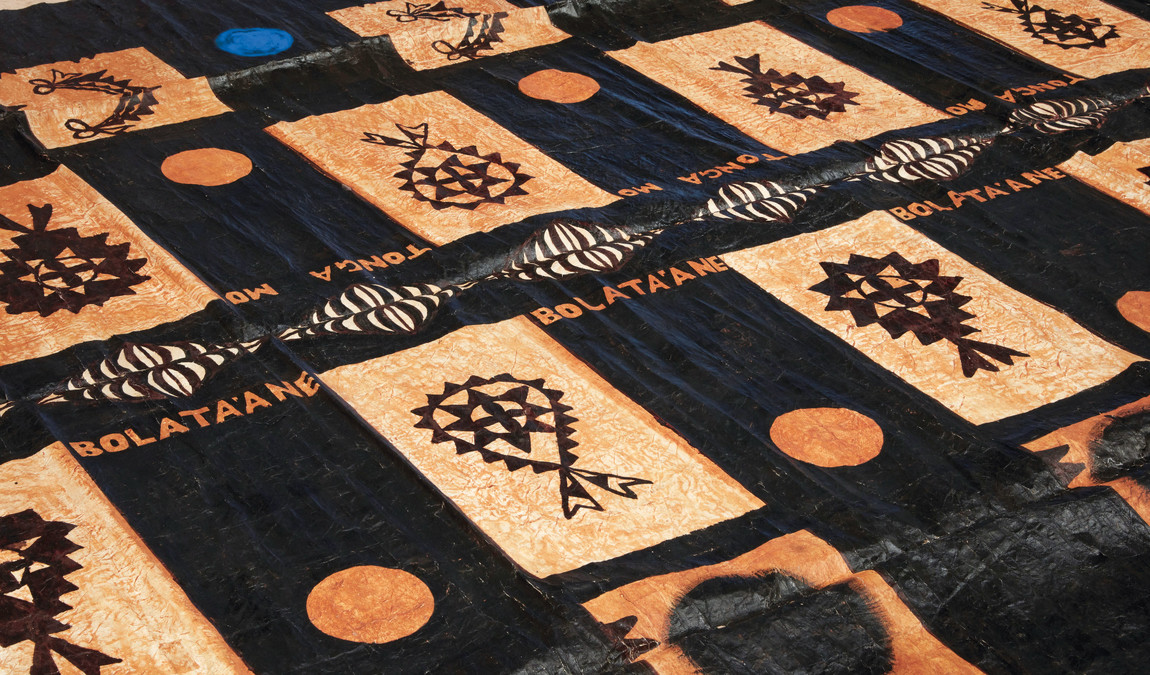
Kulimoe'anga Stone Maka Toga mo Bolata'ane (Tonga and Britain) (detail) 2008–10. Oil, clay, dye on tapa cloth. Installation view, 22nd Biennale of Sydney (2020): NIRIN, Museum of Contemporary Art Australia, Sydney. Courtesy the artist and Museum of Contemporary Art Australia. Photo: Zan Wimberley
It feels painful to raise in this context, but truth is important – the treaty signed in 1900 was not fair to Tonga and brought unnecessary limitations to Tonga’s sovereignty based on British self-interest. Academic James Bade points out that Tonga had already negotiated treaties of friendship with Germany in 1876, Great Britain in 1879 and the United States in 1886, which recognised Tonga as an independent sovereign state.
Instead, the 1899 Berlin agreement between Britain, Germany and the United States decided which Pacific countries they would influence.
In March 1990, a British official arrived to make King George Tupou agree to signing a 'protectorate'. The King refused. He eventually signed only when he was threatened with removal. The new treaty had an unagreed upon ‘silent’ condition that all Tonga’s foreign affairs be conducted by Great Britain.
So basically, England bullied Tonga into the treaty, and then intervened in their foreign affairs for seventy years. When Queen Sālote died in 1965, she had already set out plans for the end of the protectorate in 1970.
Two queens whose respective roles were intertwined. Queen Sālote’s alofa and humility towards Queen Elizabeth was presumably despite her awareness of Britain’s unjust conduct towards Tonga. I can’t believe she would have been anything but completely savvy about it, and yet her respect was genuine. I hope that Elizabeth was able to learn from her three visits to Tonga. It’s difficult though. We are still collectively unpicking the impact of colonisation globally and the Eurocentric lens it produced. A lens that sees art originating in France or London but not Nuku'alofa. A lens that only sees the world through blue eyes.
Stone tells me he sometimes struggles when people interpret his work through the lens of Western art history, without considering Tongan frames of knowledge or meaning-making. When he exhibited the works at the Sydney Biennale, someone told him the work evoked Mark Rothko.
He pauses, “They don’t want to learn about our art”.
Tongan academic Tēvita Ka'ili'li writes about tā-vā theory – a system of Tongan Indigenous theorising that makes sense of the relationship between time and space, and the significance of social relationships. He says, “Tauhi vā is an indigenous artistic device that uses symmetry to reconcile sociospatial conflicts and harmonious and beautiful sociospatial relations.” He argues Tongan arts use these attributes to restore time-space conflicts, and to mark the tā (time) in the vā (space).
The marking of the tā in the vā feels intrinsic to the ngatu ta'uli works of Kulimoe'anga Stone Maka. Perhaps it is a restoration of the vā between the two queens.








